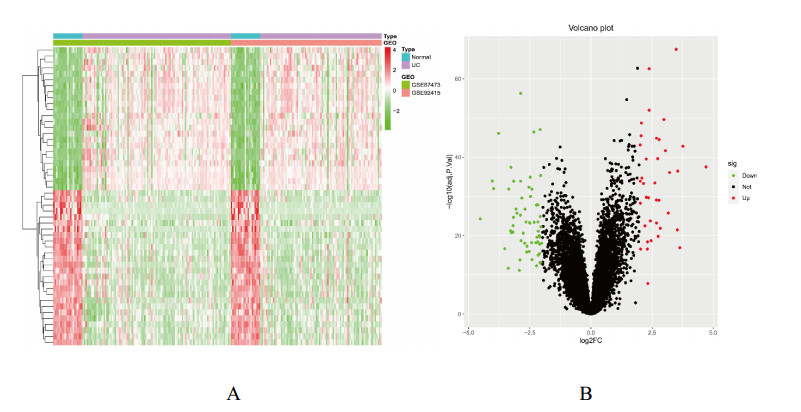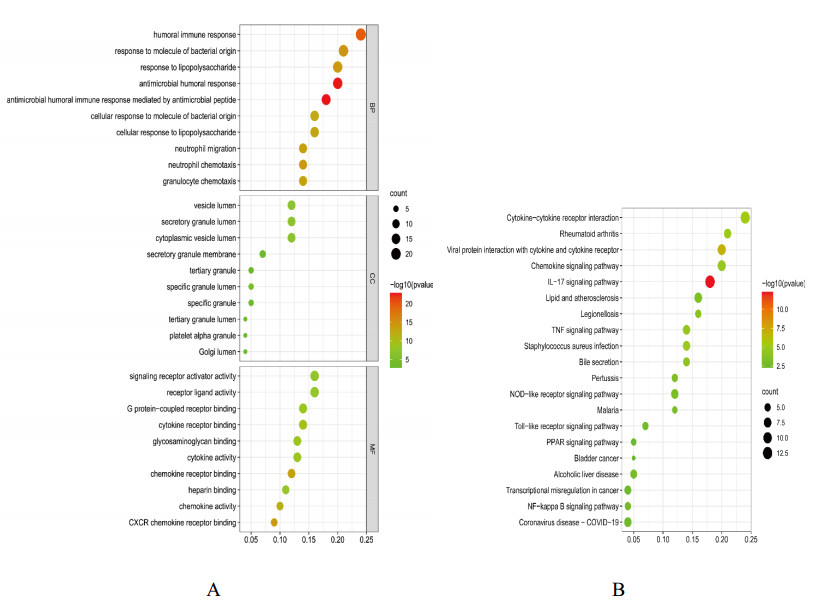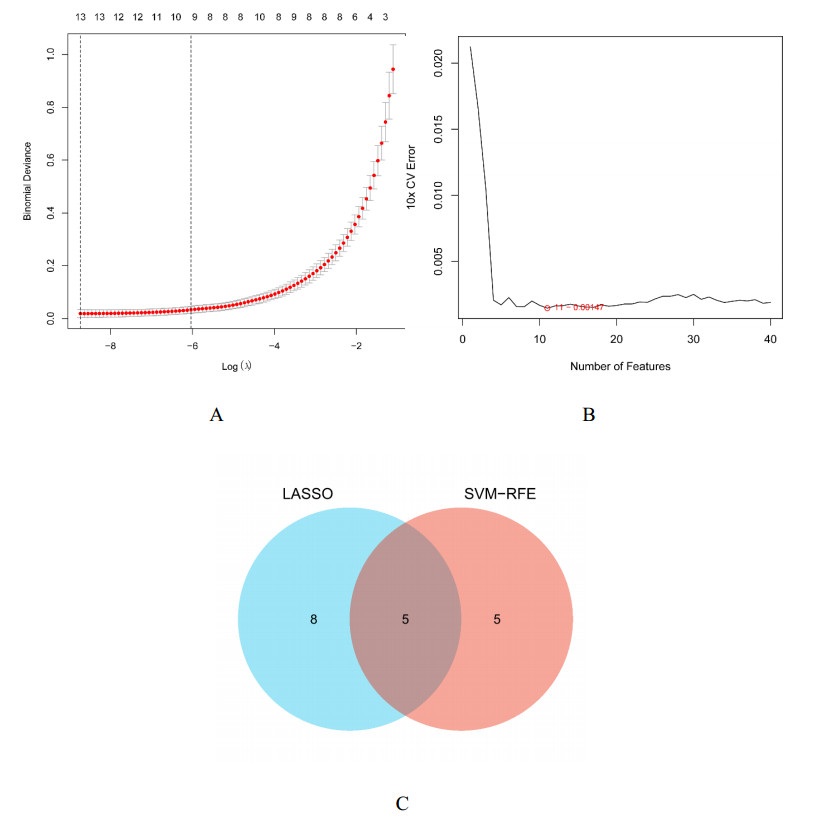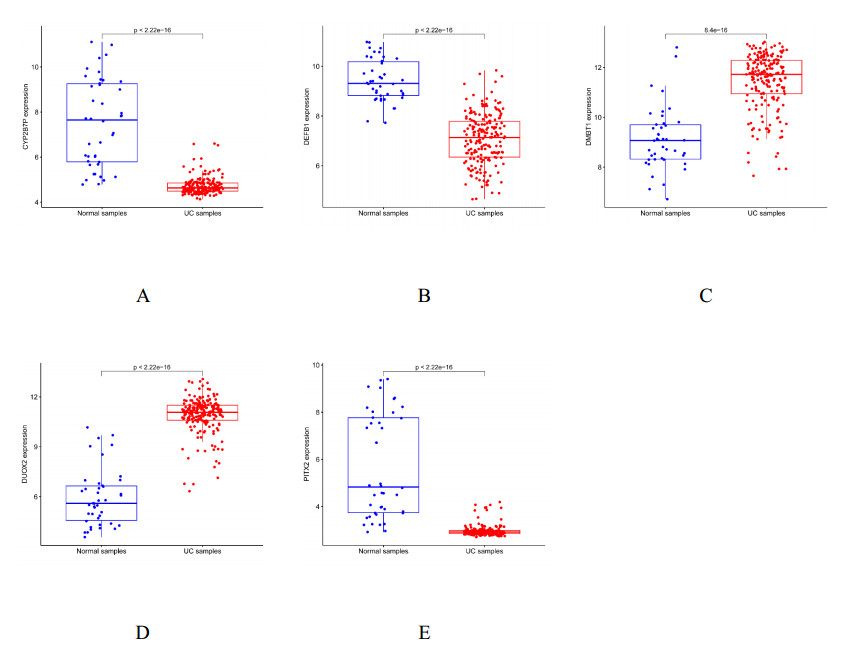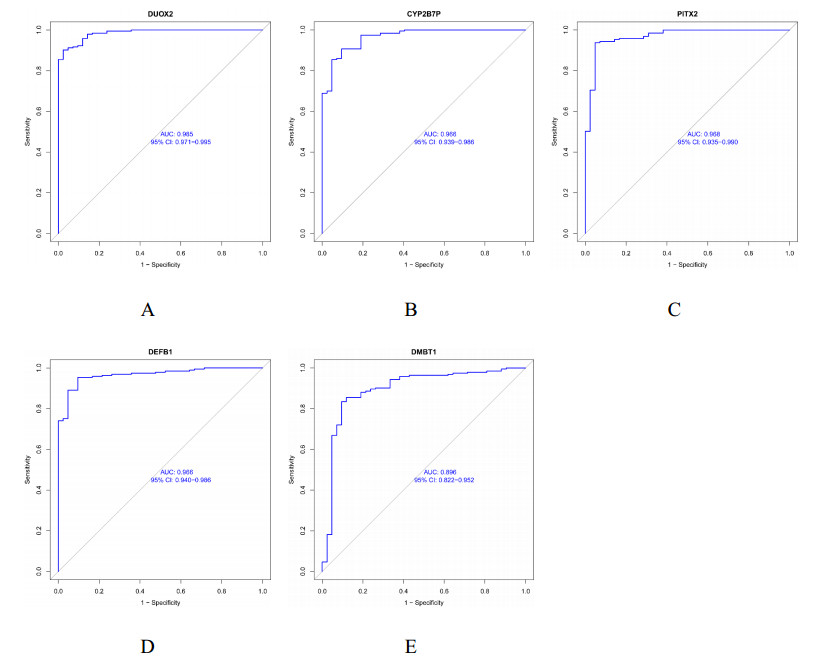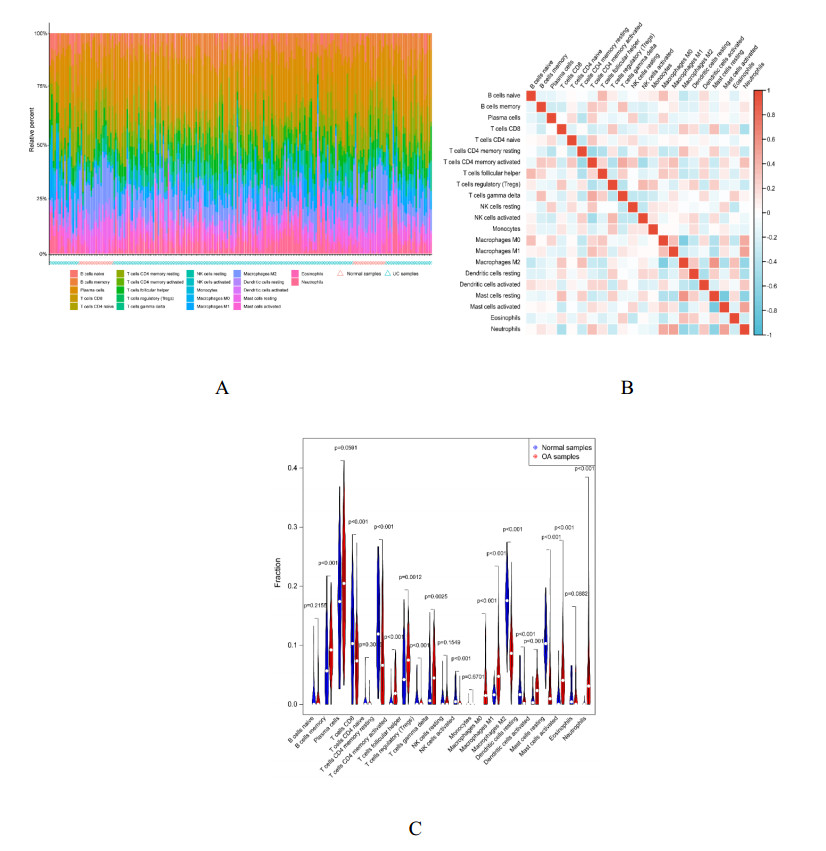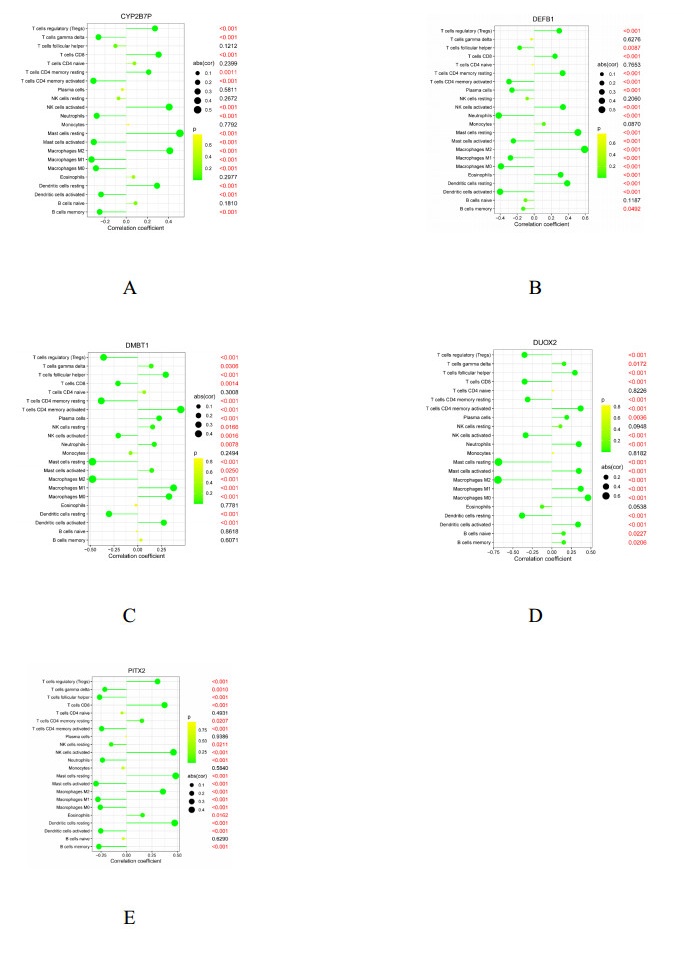1.
Introduction
Ulcerative colitis (UC) is a type of idiopathic, immune-mediated inflammatory bowel disease (IBD) with symptoms of diarrhea, abdominal pain and mucopurulent bloody stools [1]. The prevalence of IBD is more than 0.3% in numerous nations in North America, Oceania and Europe, being the highest in Norway: 505 UC cases per 100,000 people [2]. The mean annual healthcare cost per UC patient is approximately?2088, and its burden is increasing globally [3].
The pathogenesis of UC, including infection details, role of the immune system and the environment and sensitive genes, has not been fully delineated yet [4]. UC treatment aims to induce and maintain remission. However, the management of UC is extremely difficult due to its poorly known etiology [1]. The establishment of novel diagnostic biomarkers that reflect the inflammatory damage to the intestinal mucosa is important for the timely diagnosis and treatment of UC.
Recent high-throughput microarray analysis of specimens from patients and healthy subjects has allowed us to investigate various diseases at multiple levels, revealing the numerous genes activated in different tissues as well as their physiological and pathological states [5,6]. Bioinformatics and machine learning can be efficiently combined to analyze high-throughput microarray data to further explore disease mechanisms and identify potential biomarkers.
Several studies have analyzed UC and IBD microarray data [7,8,9]. Zhang identified five genes as potential indicators for UC tissue biopsy and found the DUOX2/DUOXA2 and CXCL1/CXCR2 pathways to be crucial in the development of UC [8]. Shi discovered that core differentially expressed genes (DEGs) found in UC are associated with inflammation and the immune response and that CXCR2 may indicate the degree of inflammation in UC patients [9]. These findings further reveal core features of UC pathogenesis. Further bioinformatic analysis of UC is now possible with the advances in bioinformatics technology and the application of machine learning to pathology. In this study, bioinformatic and machine learning analyses of microarray data were employed to identify prospective biomarkers for the diagnosis of UC.
2.
Materials and methods
2.1. Microarray data
The flowchart of analysis steps is shown in Figure 1. GSE87473 and GSE92415 were downloaded from Gene Expression Omnibus (www.ncbi.nlm.nih.gov/geo/) [10]. Expression data for GSE87473 were generated using 106 cases of UC and 21 healthy controls, and data for GSE92415 were generated using 87 cases of UC and 21 healthy controls. Gene probe IDs in the matrix file were converted into international standard gene names using Perl. The two datasets were normalized and merged into a metadata cohort for subsequent integrated analysis using the "limma" package in R. Furthermore, the "SVA" package in R was applied to remove batch effects. All gene expression data were subjected to log2 transformation.
2.2. Identification of DEGs
Linear models from the "limma" package in R were used to identify DEGs between colon tissues from UC patients and healthy subjects. The Benjamini–Hochberg approach was used to control the false discovery rate. Genes with adjusted p < 0.05 and log2 (fold change) > 2 were considered as DEGs. Finally, the "ggplot2" and "pheatmap" packages were used to plot the volcano plots and heat map of the DEGs, respectively.
2.3. Functional enrichment analyses
Gene Ontology (GO) is a bioinformatics resource for annotating genomes with terms such as molecular functions, cellular components and biological processes. As a comprehensive database resource, the Kyoto Encyclopedia of Genes and Genomes (KEGG) aims to provide biological interpretation of high-throughput data or genomic data, ultimately helping identify functional and metabolic pathways. In this study, GO and KEGG enrichment analyses of DEGs were performed using the "clusterProfiler" package in R. p < 0.05 was considered to indicate significant enrichment of DEGs.
2.4. Identification of diagnostic biomarkers
Two machine learning methods were applied to the potential diagnostic criteria for predicting UC status. Using the "glmnet" package in R, least absolute shrinkage selector operator (LASSO) regression was carried out to identify genes significantly associated with the discrimination between UC and healthy samples. Support vector machine (SVM) is a machine learning method that is frequently employed for classification and regression analysis. With the aim of preventing overfit, the optimum genes in the metadata cohort were filtered using recursive feature elimination (RFE). Consequently, SVM-RFE was used to filter acceptable features to discover the gene set with the highest discrimination capacity.
To estimate the prediction value for UC diagnosis, the "pROC" package in R was used. Area under the curve (AUC) of the receiver operating characteristic (ROC) curve was calculated to judge the accuracy of the diagnostic biomarkers: The higher the AUC value is, the higher the accuracy.
2.5. CIBERSORT analysis
To reveal the differences in immune characteristics between UC patients and health individuals, the CIBERSORT algorithm in R was applied to evaluate the score distribution and differential expression of 22 immune cells in the gene expression profile. The advantages of using CIBERSORT for gene expression profiling data are the removal of unknown mixture content and the removal of artifacts through deconvolution, ultimately providing an estimate of the relative proportions of the 22 immune cell subpopulations, which were displayed using the "ggpubr'' package in R. The "ggplot2" package in R was applied to create a boxplot depicting the differences between the UC and normal groups.
2.6. Statistical analysis
Continuous variables were expressed as the mean ± standard deviation, whereas categorical variables were expressed as percentages. The Mann–Whitney U test or Kruskal–Wallis H test was used to compare between non-normal data, t-test or one-way analysis of variance was used for normally distributed data, and Fisher's exact probability method or chi-squared test was used for supCount data. All data analyses in this study were performed in R, and a p-value < 0.05 was regarded as significant.
3.
Results
3.1. UC-associated DEGs
The two gene expression datasets included 193 UC cases and 42 healthy controls. In total, 102 DEGs were identified from the expression data, including 64 upregulated genes and 38 downregulated genes. Figure 2 depicts the heatmap and volcano plot for the discovered DEGs.
3.2. GO and KEGG analysis of overlapping DEGs
GO analysis revealed that DEGs associated with antimicrobial humoral immune response, humoral immune response, reaction to molecule of bacterial origin and neutrophil chemotaxis were considerably enriched (Figure 3A). KEGG analysis showed that DEGs were significantly enriched in pathways involving interleukin-17 (IL-17), cytokine–cytokine receptor interaction, rheumatoid arthritis, viral protein interaction with cytokine–cytokine receptor, Staphylococcus aureus infection and others (Figure 3B).
3.3. Determination of diagnostic biomarkers
To identify potential biomarkers for UC, two different arithmetic methods were used. LASSO regression identified 13 variables as diagnostic markers for UC (Figure 4A). SVM-RFE was used to determine a subset of 10 DEG features (Figure 4B). Five features that overlapped between the two arithmetic methods—DUOX2, DMBT1, CYP2B7P, PITX2 and DEFB1—were finally selected as key genes in UC development (Figure 4C).
3.4. The expression and significance of diagnostic markers for UC
The expression levels of DUOX2 and DMBT1 were significantly higher in UC samples than in healthy samples, while those of CYP2B7P, PITX2 and DEFB1 were significantly lower in UC samples (Figure 5).
ROC curve analysis was carried out to determine the utility of these diagnostic markers. The AUC values for DUOX2, CYP2B7P, PITX2, DEFB1 and DMBT1 were 0.985, 0.966, 0.968, 0.966 and 0.896, respectively, indicating that all of them displayed a strong ability to distinguish UC cases from normal samples (Figure 6).
3.5. Characterization of immune cell infiltration in UC patients
CIBERSORT was used to elucidate the relative proportions of 22 immune cells in UC and normal tissues, as well as their relationships with one another (Figure 7A, B). Differences were observed in the levels of memory B cells, CD8 T cells, activated and resting memory CD4 T cells, activated natural killer (NK) cells, neutrophils, activated and resting mast cells, activated and resting dendritic cells and M0, M1 and M2 macrophages.
3.6. Diagnostic biomarkers were associated with the level of immune cell infiltration
The associations between diagnostic marker expression and immune cell infiltration were investigated in greater detail. All five DEGs were correlated with regulatory T cells, CD8 T cells, resting and activated memory CD4 T cells, activated NK cells, neutrophils, resting and activated mast cells, M0, M1 and M2 macrophages and resting and activated dendritic cells. DUOX2, DMBT1, CYP2B7P, PITX2 and DEFB1 may be implicated in the progression of UC by modulating several immune cells.
4.
Discussion
UC is a common type of IBD with various degrees of mucosal lesions and recurrent episodes [11]. By definition, UC is considered to be limited to the superficial layer of the rectal and colonic mucosa, but given its proximal expansion and effects on colonic function, it should actually be viewed as a progressive condition with a dismal prognosis [12]. Prompt diagnosis and treatment are crucial for patients with UC, but such early diagnostic tools are still absent from clinical practice. Based on our examination of the two Gene Expression Omnibus datasets, we could highlight 102 DEGs that distinguished UC samples from healthy controls. Analysis of these DEGs using GO terms revealed that they were disproportionately involved in processes related to neutrophil chemotaxis, response to molecules of bacterial origin, humoral immune response and antimicrobial peptide-mediated antimicrobial humoral immune response. These DEGs were primarily implicated in pathways associated with IL-17, cytokine–cytokine receptor interaction, rheumatoid arthritis, viral protein interaction with cytokine–cytokine receptor and S. aureus infection, as shown by KEGG analysis. These findings suggest that these DEGs are actively engaged in immunological processes and may be critical for the development of UC.
From the initial screen of 102 DEGs, two machine learning techniques identified five genes as potential diagnostic biomarkers for UC. Dual oxidase 2 (DUOX2) is a member of the nicotinamide adenine dinucleotide phosphate oxidase family. It is expressed apically in the epithelial cells of the ileum and colon, where it catalyzes the generation of reactive oxygen species during normal cellular processes and phagocytosis [13]. DUOX2 can regulate the interaction between the intestinal microbiota and the mucosa while maintaining the normal intestinal mucosal barrier function [8,14]. Deleted in malignant brain tumors 1 (DMBT1) is an innate immune protein expressed on the mucosal surfaces of various human tissues, particularly throughout the luminal gastrointestinal tract [15,16]. It promotes epithelial differentiation and angiogenesis. Cytochrome 2B7P (CYP2B7P) is a pseudogene from the cytochrome P450 family. Its involvement in disease progression has been rarely reported [17]. Paired like homeodomain 2 (PITX2) contributes to intestinal formation and symmetry through multiple signaling pathways [18,19]. Due to its importance in DNA methylation and tumor immune infiltration, it may be connected to an increased risk of carcinogenesis in UC patients [20,21]. Beta-defensin 1 (DEFB1) is an antimicrobial peptide associated with surface resistance of epithelial cells to microbial invasion. Downregulation of DEFB1 leads to an impaired intestinal mucosal barrier function, which is closely related to the development of UC [22,23]. ROC assays confirmed the strong ability of these five diagnostic genes to screen UC specimens from normal specimens, verifying their promise as prospective biomarkers for UC.
Recent evidence highlights the critical role of immune cell infiltration in the onset and progression of UC. Dendritic cells and macrophages present antigens and secrete several proinflammatory cytokines, inducing a Th2 cell immune response [24,25]. Compared with healthy controls, UC patients had a lower percentage of Foxp3+CD4+ T cells within their peripheral blood mononuclear cell population [26], an accumulation of activated neutrophils in the circulation and colonic tissue [27] and NK cells with impaired mitochondrial function and attenuated killing ability [28]. The intestinal T cell infiltrates in UC patients were richer in CD4+, regulatory and central memory T cells, while the proportions of CD8+ and CD103+ T cells were lower [29]. The evolutionary direction of colonic T cells in UC patients is in the GZMK+TNF+ effector state and in the immunomodulatory characteristic with clonally expanded IL-26 state. The imbalance in their evolutionary expressions may promote intestinal tissue destruction [30]. Mast cells are engaged in regulating intestinal mucosal permeability and barrier function, and their degranulation has been linked to the etiology of UC [31,32]. In the absence of IL-10 signaling, macrophages promote the progression of UC by activating NOD-like receptor pyrin domain-containing 3 inflammasome and enhancing proinflammatory cytokine production [33].
Assessing the extent and diversity of immune cell infiltration offers insights into the molecular mechanisms underlying UC and helps identify new immunotherapeutic targets. Regulatory T cells, CD8 T cells, resting and activated memory CD4 T cells, activated NK cells, neutrophils, resting and activated mast cells, M0 M1 and M2 macrophages and resting and activated dendritic cells were all associated with the five core DEGs in this study, suggesting that these genes may play a role in the pathogenesis of UC by forming close connections with immune cells.
To assist the early diagnosis and to further characterize the pathogenesis of UC, LASSO regression and SVM-RFE were used to screen potential biomarkers, while CIBERSORT was used to profile the immune cell infiltrates in UC, which has been rarely reported in the past. This study has some limitations. First, molecular biology experiments or large-scale clinical trials were not performed to validate the diagnostic efficacy of the five core genes. Second, this study only establishes a correlation between UC and immune cells, not a causal relationship. More convincing evidence is required to reveal the intricate interactions between immune cells and genes.
Computational biology research provides new ideas and prospects for biological experiments in the study of UC [9]. Computational biology techniques are evolving, and microRNAs (miRNAs) and long noncoding RNAs (lncRNAs) may be the future direction for UC biomarker research. In recent years, several new biocomputational models have been developed, including graph convolutional neural networks and conditional random fields [34], logistic matrix factorization with neighborhood regularized [35] and a network distance analysis model for predicting lncRNA–miRNA associations [36]. Applying these new models to UC research will help reveal the critical role of miRNA–lncRNA interactions and their functions in the pathogenesis of UC. Deep learning algorithms are also improving constantly [37,38]. The use of updated bioinformatic analysis tools offers an in-depth understanding of the essential characteristics of UC.
5.
Conclusions
This study identified five candidate genes—DUOX2, DMBT1, CYP2B7P, PITX2 and DEFB1—as prospective biomarkers for UC, offering new insight into the development of the disease.
Acknowledgments
This work was supported by the National Natural Science Foundation of China (No. 81830118), China Academy of Chinese Medical Sciences Innovation Fund (No. CI 2021A01012), Administration of Traditional Chinese Medicine Digestive Refractory Disease Inheritance and Innovation Team Project (No. ZYYCXTD-C-C202010) and China Academy of Chinese Medical Sciences Excellent Young Talent Cultivation Fund (No. ZZ 15-YQ-002).
Conflict of interest
The authors declare that they have no potential conflicts of interest.
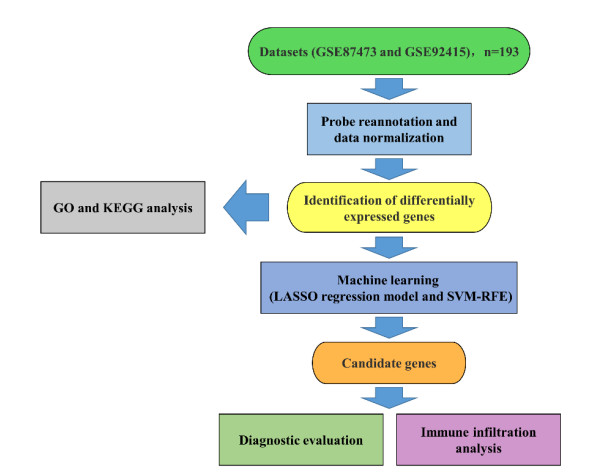









 DownLoad:
DownLoad:
